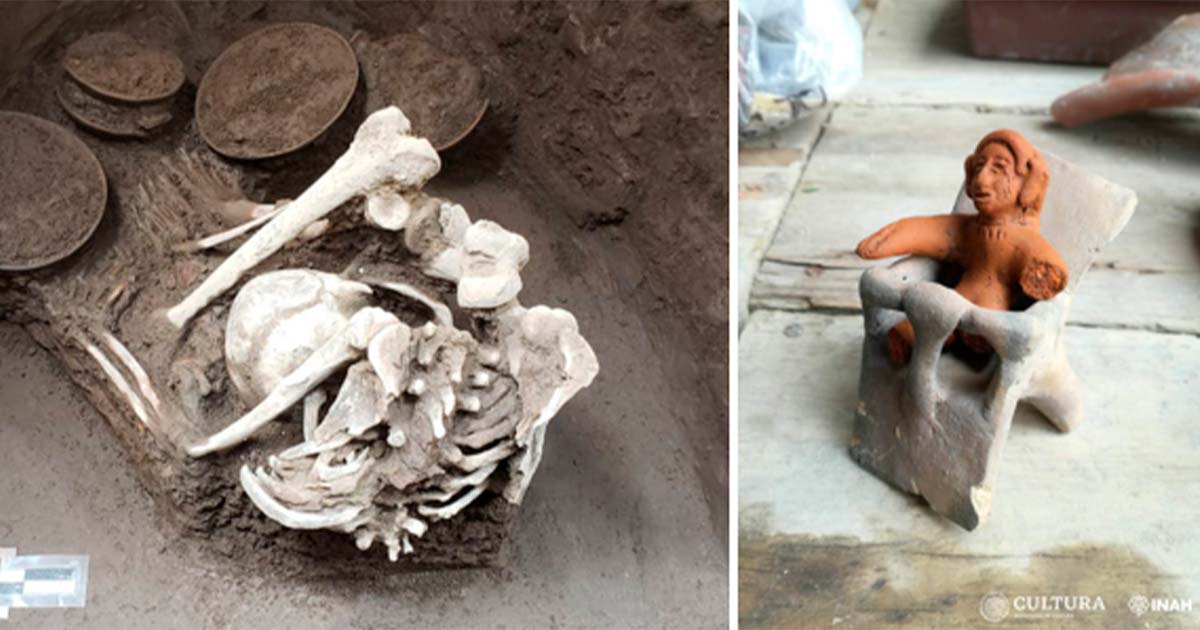Archaeologists in Mexico Uncover Remains of a Teotihuacan Village Almost 1,600 Years Old
Archaeologists from the National Institute of Anthropology and History (INAH) have made a groundbreaking discovery in Mexico City's Tlatelolco area - the remains of a Teotihuacan village dating back to approximately 450-650 AD. Although the village was initially identified during construction works in the 1960s, recent excavations provide a much more comprehensive understanding of its significance.
Identification of a Teotihuacan Village
The settlement was identified through various constructive elements such as channels, floors, stone alignments, post holes, and an artesian well, all active during the Classic period in the Late Xolalpan-Metepec phases of Teotihuacan era. Large concentrations of ceramics and the unearthing of three human burials, including a sub adult and two adults accompanied by polished bowls (probably funerary offerings) with Teotihuacan characteristics, which further provided evidence for the village's existence.
"With these new findings, the existence of a Teotihuacan occupation village in the Tlatelolco area has been consolidated and demonstrated," report archaeologists Juan Carlos Campos Varela and Mara Abigail Becerra Amezcua, who are leading the investigation, supported by a dozen specialized technical workers.
Between March and June 2023, a research team from the Directorate of Archaeological Salvage of the National Institute of Anthropology and History (INAH) made significant discoveries of a Teotihuacan occupation village near the Nonoalco-Tlatelolco Urban Complex in Mexico City. This site had been initially reported by archaeologist Francisco González Rul during the construction of modern landmark buildings between 1960 and 1964, according to an INAH press release.
- Teotihuacán: The Ancient City Designed to Track Time (Video)
- Over 500 Pre-Hispanic Obsidian Mine Shafts Uncovered in Central Mexico

Extensive excavations unearthed architectural components of a Teotihuacan village. (Juan Carlos Campos Varela/INAH)
Teotihuacan: A Complex Economy, a Powerful City-State
Teotihuacán, at its zenith, was a powerful city-state with an estimated population of 125,000 inhabitants, making it one of the largest cities in the ancient world. Spanning an impressive 18 square kilometers (6.94 mi), the city boasted over 2,000 structures, showcasing the remarkable architectural prowess of its builders.
While González Rul had previously suggested the Tlatelolco settlement was a village of fishermen-gatherers relying on self-subsistence and lake resources, the new evidence points to a more complex economy.
"The complexity of the evidence recovered in this 2023 [excavation] allows us to consider that the economy of this village should not have been only self-subsistence and gathering, but mixed production, with a surplus lake use, perhaps based on hunting together with an artisanal production of ceramics, or lithic, possibly specialized, since several fragments of solid and articulated modeled figurines, green stone objects, shell, funerary offerings and various obsidian and flint projectile points were found”, explain both specialists.

Teotihuacan figurine among items found in excavation. (Juan Carlos Campos Varela/INAH)

Ceramic toys, vessels discovered. (Juan Carlos Campos Varela/INAH)
Additionally, the discovery of figurines, green stone artifacts, and obsidian and flint projectile points indicates a thriving artisan community.
Despite its rural setting, the village maintained crucial connections of exchange and dependency with other Teotihuacán governing centers along the western shore of Lake Texcoco.
The excavations in the 400-square-meter (4305.56 sq ft) property within the San Rafael-Juárez-Guerrero heritage protection area also revealed evidence of Mexica occupation, four historical occupations (from the 18th, 19th, and two from the 20th century), in addition to the Teotihuacan occupation.
The Mexica occupation associated with the Tlatelolca neighborhood of Tolquechiuca started in the Late Postclassic period (1338-1521) and continued into the Early Colonial period (1521-1620).
Excavations also unveiled evidence of the Aztec occupation during the Late Postclassic Period. This discovery highlights the village's resilience and continued importance through the centuries. The layers dating back to the 18th, 19th, and 20th centuries AD demonstrating the continuous human activity in the region over time.
- The Powerful and Mysterious Spider Woman of Mexico
- Diplomacy by Spider Monkey? Maya Peace Offering Found at Teotihuacan
The archaeological team also found a network of channels that delimited ‘chinampería’ spaces. The "chinampería" is a unique Mesoamerican agricultural system developed by the Aztecs in the Valley of Mexico, particularly in the region around Lake Texcoco. This innovative technique involved the creation of artificial islands on the lake's shallow waters to cultivate crops and vegetables.
Chinampas were essential in sustaining the growing population of the Aztec capital, Tenochtitlan, and its neighboring towns like Tlatelolco. Within these channels, the researchers unearthed numerous ceramic vessels, a headless seated sculpture, and complete and semi-complete objects from the Late Aztec III Period (1440-1521 AD), reports The Heritage Daily.
Top image: Burial of the adult from the Teotihuacan village in Mexico. Source: Marisol Bautista Roquez/ INAH
By Sahir Pandey
References
Milligan, M. 2023. ARCHAEOLOGISTS UNCOVER TEOTIHUACANO VILLAGE IN MEXICO CITY. Available at: https://www.heritagedaily.com/2023/07/archaeologists-uncover-teotihuacano-village-in-mexico-city/148111.
Ritter, M. 2023. 1,400-year-old village — with burial ground and colorful ceramics — revealed. See them. Available at: https://www.miamiherald.com/news/nation-world/world/article277821383.html.

















